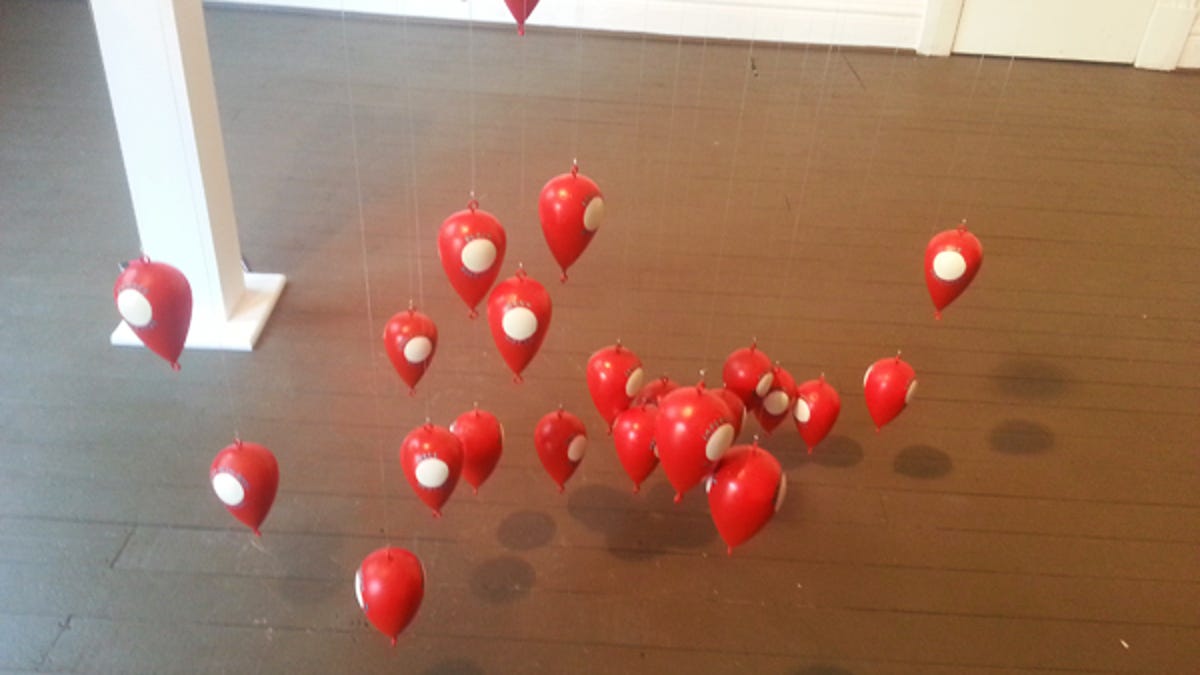Artist explores the social landscape through Facebook check-ins
Sydney-based artist Grace Kingston has created Here You Are, a study of the culture of Sydney's inner west based on information collated from Facebook.

(Credit: Michelle Starr/CNET Australia)
Sydney-based artist Grace Kingston has created Here You Are, a study of the culture of Sydney's inner west based on information collated from Facebook.
If you could visualise your friends' favourite hang-out spots in your area based on information collated from Facebook check-ins, what would it look like? For artist Grace Kingston, it looks like a collection of plumb bobs or fishing sinkers suspended from the ceiling, swaying or twisting gently in the air currents. It looks like a series of selfies and a garish LED sign flashing on the wall.
This is Here You Are. "The presence of social media has become ubiquitous in contemporary culture. Yet, despite being able to socialise with anyone, in any corner of the globe, we still long to "be" somewhere. It is this desire that has lead to the rise of the check-in on Facebook, Foursquare and other social media sites. Usually accompanied by a picture and text, these updates serve as largely rhetorical acts of promotion and records of a person's life, broadcast to an ambiguous audience," Kingston said on her website. "I have acted as an artist-anthropologist, studying the city as it is seen in the real world and as it is seen through the screen. I wanted to create a new topographical map to investigate the landscape of "cool" within the area."
To collect the data, she enlisted the aid of programmer Nic Cope. He wrote a web-based script that pulled data from AppEngine, Python, Twitter Bootstrap and the Facebook Graph API, allowing Kingston to view every check-in ever made by her friends, hand counting to avoid duplicates and compiling it into a dataset. This was then used to create the drop-pin mobile.
"The installation is geographically aligned with the area and based on a to-scale map of a 1 kilometre radius of the gallery, in which 1 centimetre equals 1 metre," Kingston said. "The drop pins are positioned as to the number of check-ins at each location, where 1 centimetre equals one check-in; for example, Thai Riffic received seven check-ins so is positioned 7 centimetres from the floor."
The three most popular locations — the Courthouse Hotel, the ZanziBar and the Town Hall Hotel — were chosen by Kingston as a backdrop for that most ubiquitous form of social media self-advertisement: the selfie.
Meanwhile, a bright LED flashes status updates that accompany the check-ins, revealing a love of friends, beer and a good time; outside of the context of their social network setting, they seem like a stream of endless bird chatter, broadcasting the presence of someone, somewhere, doing something — seeking recognition, even though they may be surrounded by people they care about.
"Separated from their usual online context, the writings appear as humorous and absurd, parodying the self-advertising nature that ... social media encourages," Kingston said.
Here You Are is on display at Archive_, 5 Eliza Street, Newtown, until 19 October 2013.

